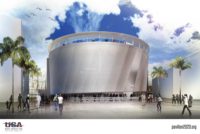Since the 1990s, the U.S. State Department has been barred from spending public funds on world expo pavilions. The result has been a series of disasters: the U.S. was a no-show at the expo in Hanover, Germany, in 2000; it then built lackluster, overly commercialized pavilions for the 2005 and 2010 expos in Aichi, Japan, and Shanghai, China.
Last year, the U.S. made a strong showing at the Milan Expo, with its theme “Feeding the Planet, Energy for Life.” But now comes a denouement that may cripple chances of there ever being a successful U.S. pavilion again: the architect, the exhibition designer, and the contractor have been paid only a fraction of what they are owed for work on the pavilion.
Because of the 1990s law, funds for expo pavilions have to be raised privately. And the group formed to raise funds for the Milan pavilion hasn’t come close to covering its approximately $60 million in costs.
Architect James Biber, whose Manhattan firm designed the pavilion, with its Coney Island Boardwalk–style ramps and 7,200- square-foot living wall, says he has been paid less than half of the $2.2 million he is owed under his 2014 contract. He says that the approximately $1 million shortfall is a “huge percentage” of his firm’s annual revenue, and that he has had to lay off staff because of it.
“It’s unconscionable and it’s disgraceful,” Biber says.
Thinc Design, which created the exhibitions, is also owed about $1 million, says its president, Thom Hennes. “And it’s not like that money’s profit. Most of it has already been spent.”
In 2014, a nonprofit called Friends of the USA Pavilion Milan 2015 was chosen by the State Department to construct and operate the building. The group (a partnership of the James Beard Foundation and the International Culinary Center) hired Biber, who then brought in Thinc and other consultants.
Altogether, 40 creditors are owed about $26 million, according to Politico, the website that broke the story this month. The largest sum, about $13 million, is owed to Nussli, the Swiss company that built the pavilion.
Reached on his cell phone, Charlie K. Faas, the CEO of the Friends group, said, “We have full intention of doing everything we can do to get everyone paid.” He repeated the statement several times, declining to elaborate.
Fund raisers for the 2010 Shanghai pavilion were able to cover the $60 million cost of that building, according to Politico, in part because then-Secretary of State Hillary Clinton strong- ly supported the effort. Far less was raised for the 2015 pavilion, during John Kerry’s tenure as Secretary of State, perhaps because U.S. com- panies looking to make inroads in China in 2010 did not feel the same urgency about the smaller Italian market five years later.
Now fund raising is effectively over. “Why would any private organization give money to an expo that ended six months ago?” Biber asked rhetorically. “It can only be resolved by the fed- eral government.” According to sources who participated in a recent conference call between the Friends group and the creditors, there was discussion about whether federal departments other than State, such as the Department of Agriculture, could make up the shortfall. Another confer- ence call is scheduled for March 24.
Biber says he knew from the start that fund raising would be difficult, and he even gave the Friends group a liberal payment schedule to ease its cash flow. He also began work almost a year before there was money to pay him, he says, “because that was the only way the pavilion was going to get built in time.”
He says he became aware of the shortfall last spring, after the pavilion was already open. “By the summer,” he says, “we knew the deficit wasn’t diminishing fast enough.” In August, the Friends group considered closing the pavilion, mid-expo, to avoid incurring additional debt.
Altogether, more than 6 million people visited the pavilion. Thanks in part to the circulation patterns devised by Biber, it was one of the few pavilions for which visitors didn’t have to spend hours waiting on line.
Now it’s Biber who’s waiting. As for the group that failed to pay him, he says, “For the most part, I like these people. You can point the fingers lots of ways.”
The next world expo will be in Dubai in 2020; already BIG, Foster + Partners, and Grimshaw Architects are designing center- piece pavilions. If there is to be a U.S. pavilion at the Dubai expo, Biber says, “Congress is going to have to change the system.”





Post a comment to this article
Report Abusive Comment